ACC307 Accounting Theory: Evaluating Managerial Pay at Woolworths Ltd.
VerifiedAdded on 2023/06/11
|10
|2741
|99
Report
AI Summary
This report provides an in-depth analysis of Woolworths Limited's managerial pay structure, focusing on the compensation contract of the CEO and the balance between short-term and long-term performance-based incentives. It examines the proportion of performance-based pay, the accounting performance measures used to determine bonuses, and potential accounting decisions the CEO might make to maximize their bonus. The report also explores how agency theory explains the various remuneration components and discusses bonus plans as a way of reducing agency problems between managers and shareholders. Furthermore, it addresses the concerns of a lending officer in a leading bank, including covenants in debt agreements, agency problems, and the use of accounting information to assess risk. The analysis considers the importance of balancing managerial motivation with potential risks and the need for strategic financial planning to ensure effective business functioning.
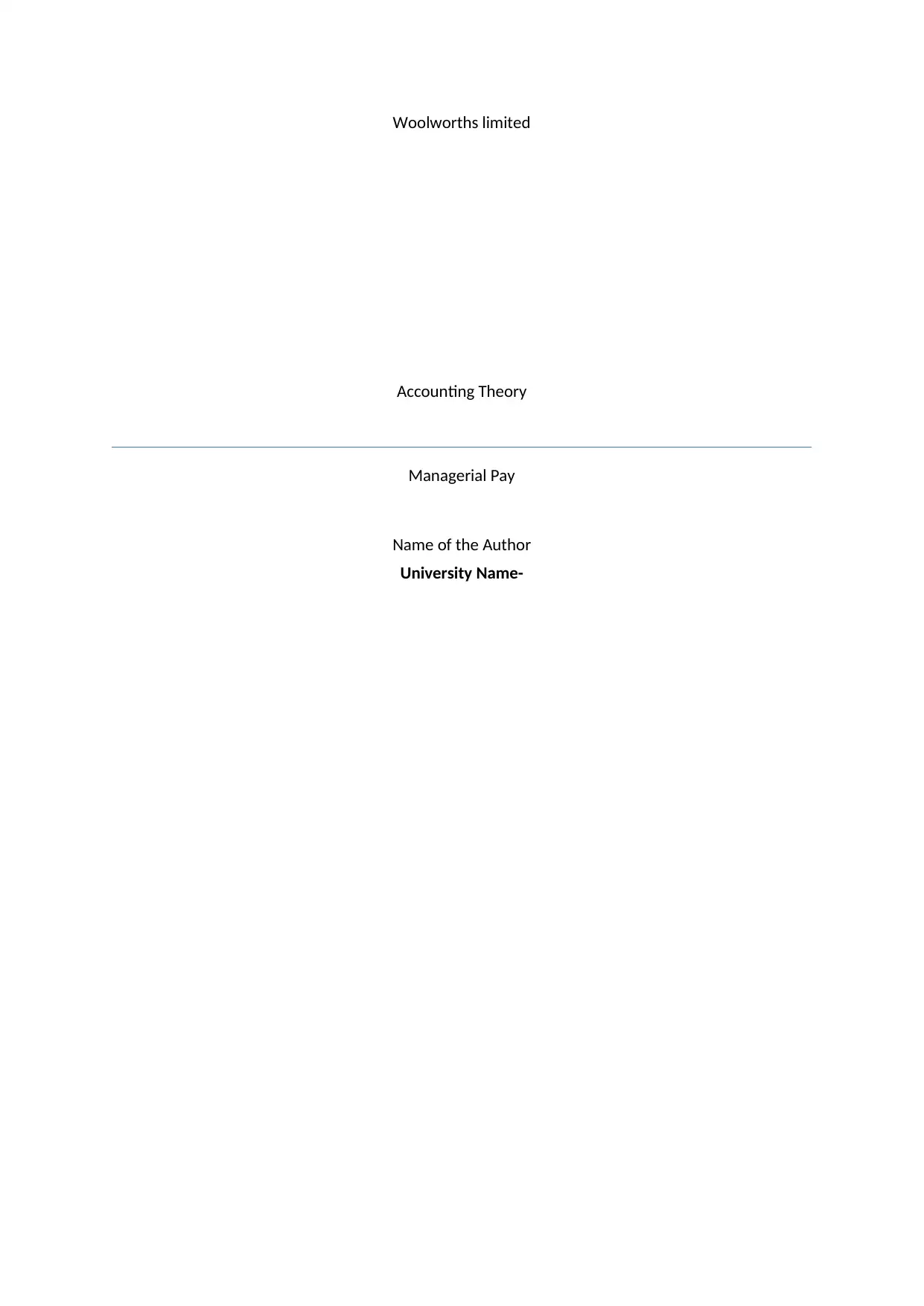
Woolworths limited
Accounting Theory
Managerial Pay
Name of the Author
University Name-
Accounting Theory
Managerial Pay
Name of the Author
University Name-
Paraphrase This Document
Need a fresh take? Get an instant paraphrase of this document with our AI Paraphraser
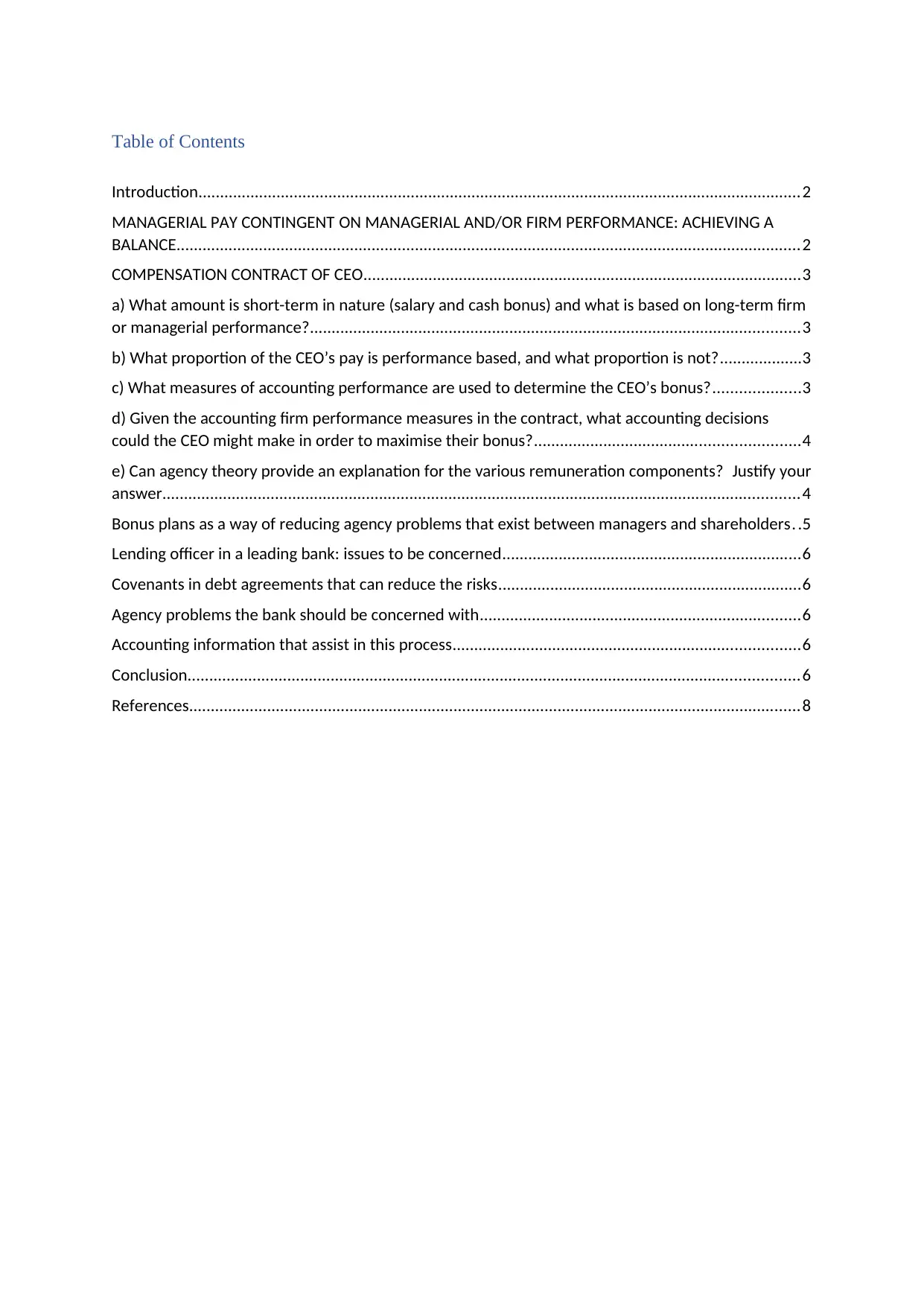
Table of Contents
Introduction...........................................................................................................................................2
MANAGERIAL PAY CONTINGENT ON MANAGERIAL AND/OR FIRM PERFORMANCE: ACHIEVING A
BALANCE................................................................................................................................................2
COMPENSATION CONTRACT OF CEO.....................................................................................................3
a) What amount is short-term in nature (salary and cash bonus) and what is based on long-term firm
or managerial performance?.................................................................................................................3
b) What proportion of the CEO’s pay is performance based, and what proportion is not?...................3
c) What measures of accounting performance are used to determine the CEO’s bonus?....................3
d) Given the accounting firm performance measures in the contract, what accounting decisions
could the CEO might make in order to maximise their bonus?.............................................................4
e) Can agency theory provide an explanation for the various remuneration components? Justify your
answer...................................................................................................................................................4
Bonus plans as a way of reducing agency problems that exist between managers and shareholders. .5
Lending officer in a leading bank: issues to be concerned.....................................................................6
Covenants in debt agreements that can reduce the risks......................................................................6
Agency problems the bank should be concerned with..........................................................................6
Accounting information that assist in this process................................................................................6
Conclusion.............................................................................................................................................6
References.............................................................................................................................................8
Introduction...........................................................................................................................................2
MANAGERIAL PAY CONTINGENT ON MANAGERIAL AND/OR FIRM PERFORMANCE: ACHIEVING A
BALANCE................................................................................................................................................2
COMPENSATION CONTRACT OF CEO.....................................................................................................3
a) What amount is short-term in nature (salary and cash bonus) and what is based on long-term firm
or managerial performance?.................................................................................................................3
b) What proportion of the CEO’s pay is performance based, and what proportion is not?...................3
c) What measures of accounting performance are used to determine the CEO’s bonus?....................3
d) Given the accounting firm performance measures in the contract, what accounting decisions
could the CEO might make in order to maximise their bonus?.............................................................4
e) Can agency theory provide an explanation for the various remuneration components? Justify your
answer...................................................................................................................................................4
Bonus plans as a way of reducing agency problems that exist between managers and shareholders. .5
Lending officer in a leading bank: issues to be concerned.....................................................................6
Covenants in debt agreements that can reduce the risks......................................................................6
Agency problems the bank should be concerned with..........................................................................6
Accounting information that assist in this process................................................................................6
Conclusion.............................................................................................................................................6
References.............................................................................................................................................8
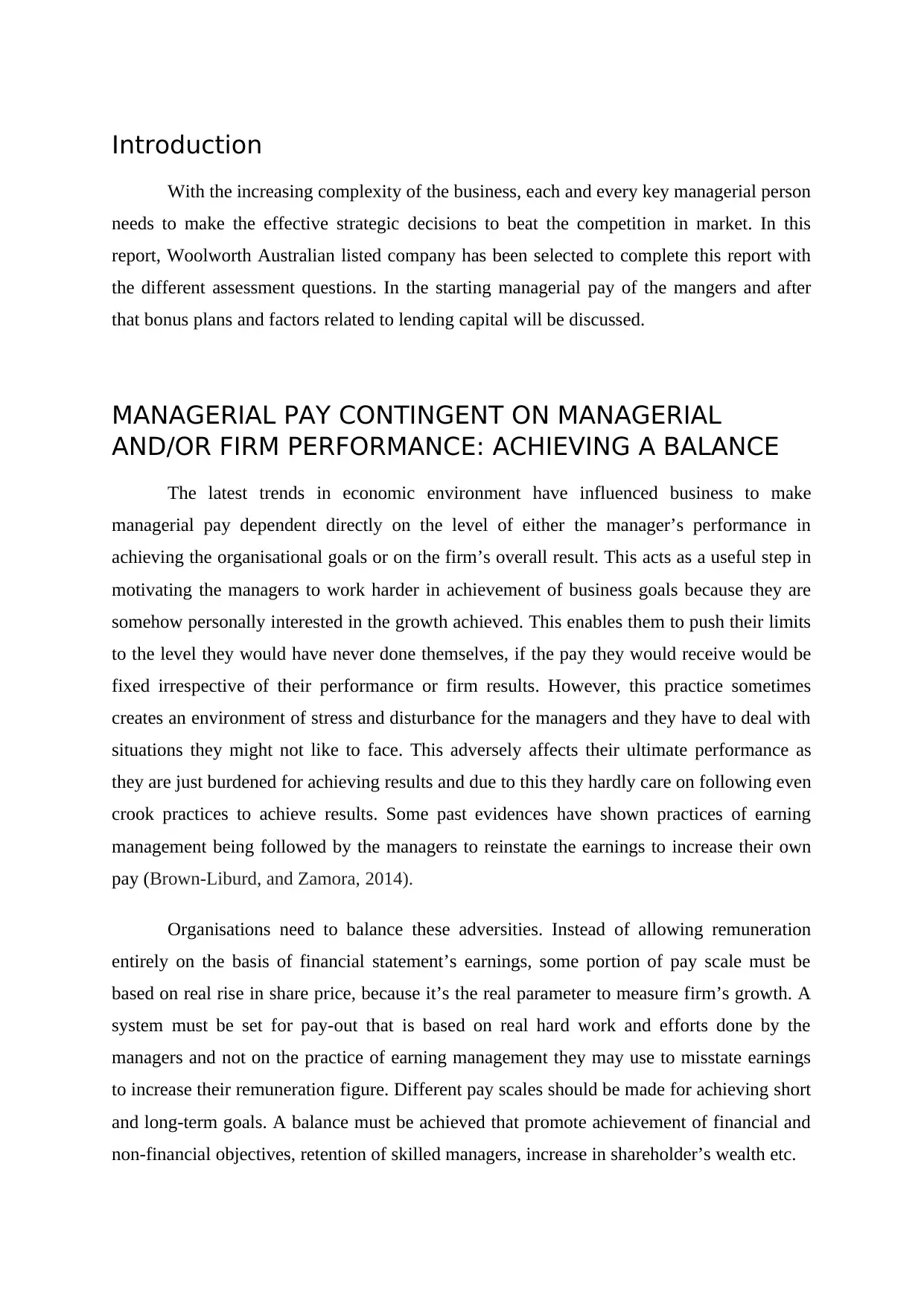
Introduction
With the increasing complexity of the business, each and every key managerial person
needs to make the effective strategic decisions to beat the competition in market. In this
report, Woolworth Australian listed company has been selected to complete this report with
the different assessment questions. In the starting managerial pay of the mangers and after
that bonus plans and factors related to lending capital will be discussed.
MANAGERIAL PAY CONTINGENT ON MANAGERIAL
AND/OR FIRM PERFORMANCE: ACHIEVING A BALANCE
The latest trends in economic environment have influenced business to make
managerial pay dependent directly on the level of either the manager’s performance in
achieving the organisational goals or on the firm’s overall result. This acts as a useful step in
motivating the managers to work harder in achievement of business goals because they are
somehow personally interested in the growth achieved. This enables them to push their limits
to the level they would have never done themselves, if the pay they would receive would be
fixed irrespective of their performance or firm results. However, this practice sometimes
creates an environment of stress and disturbance for the managers and they have to deal with
situations they might not like to face. This adversely affects their ultimate performance as
they are just burdened for achieving results and due to this they hardly care on following even
crook practices to achieve results. Some past evidences have shown practices of earning
management being followed by the managers to reinstate the earnings to increase their own
pay (Brown-Liburd, and Zamora, 2014).
Organisations need to balance these adversities. Instead of allowing remuneration
entirely on the basis of financial statement’s earnings, some portion of pay scale must be
based on real rise in share price, because it’s the real parameter to measure firm’s growth. A
system must be set for pay-out that is based on real hard work and efforts done by the
managers and not on the practice of earning management they may use to misstate earnings
to increase their remuneration figure. Different pay scales should be made for achieving short
and long-term goals. A balance must be achieved that promote achievement of financial and
non-financial objectives, retention of skilled managers, increase in shareholder’s wealth etc.
With the increasing complexity of the business, each and every key managerial person
needs to make the effective strategic decisions to beat the competition in market. In this
report, Woolworth Australian listed company has been selected to complete this report with
the different assessment questions. In the starting managerial pay of the mangers and after
that bonus plans and factors related to lending capital will be discussed.
MANAGERIAL PAY CONTINGENT ON MANAGERIAL
AND/OR FIRM PERFORMANCE: ACHIEVING A BALANCE
The latest trends in economic environment have influenced business to make
managerial pay dependent directly on the level of either the manager’s performance in
achieving the organisational goals or on the firm’s overall result. This acts as a useful step in
motivating the managers to work harder in achievement of business goals because they are
somehow personally interested in the growth achieved. This enables them to push their limits
to the level they would have never done themselves, if the pay they would receive would be
fixed irrespective of their performance or firm results. However, this practice sometimes
creates an environment of stress and disturbance for the managers and they have to deal with
situations they might not like to face. This adversely affects their ultimate performance as
they are just burdened for achieving results and due to this they hardly care on following even
crook practices to achieve results. Some past evidences have shown practices of earning
management being followed by the managers to reinstate the earnings to increase their own
pay (Brown-Liburd, and Zamora, 2014).
Organisations need to balance these adversities. Instead of allowing remuneration
entirely on the basis of financial statement’s earnings, some portion of pay scale must be
based on real rise in share price, because it’s the real parameter to measure firm’s growth. A
system must be set for pay-out that is based on real hard work and efforts done by the
managers and not on the practice of earning management they may use to misstate earnings
to increase their remuneration figure. Different pay scales should be made for achieving short
and long-term goals. A balance must be achieved that promote achievement of financial and
non-financial objectives, retention of skilled managers, increase in shareholder’s wealth etc.
⊘ This is a preview!⊘
Do you want full access?
Subscribe today to unlock all pages.

Trusted by 1+ million students worldwide
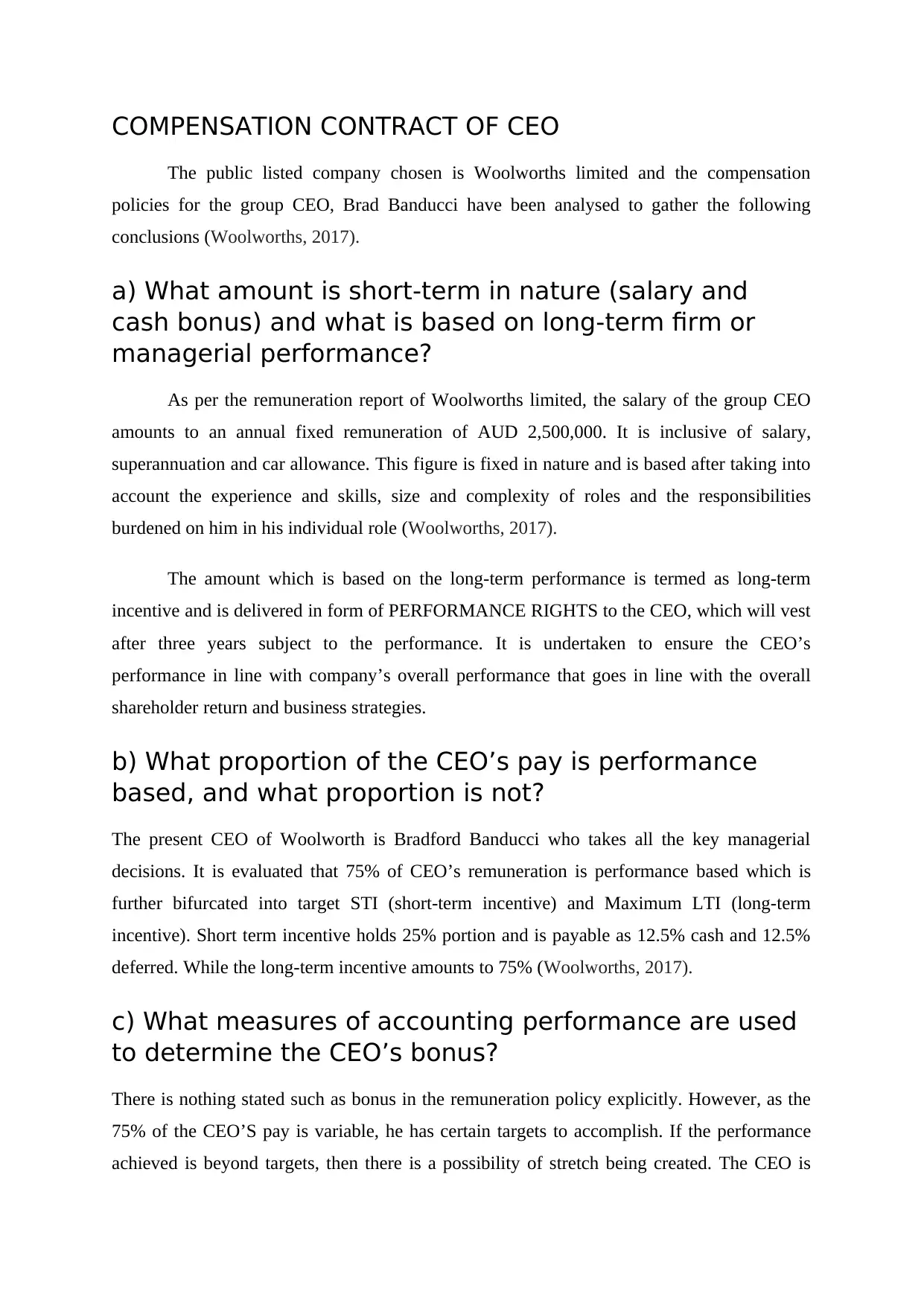
COMPENSATION CONTRACT OF CEO
The public listed company chosen is Woolworths limited and the compensation
policies for the group CEO, Brad Banducci have been analysed to gather the following
conclusions (Woolworths, 2017).
a) What amount is short-term in nature (salary and
cash bonus) and what is based on long-term firm or
managerial performance?
As per the remuneration report of Woolworths limited, the salary of the group CEO
amounts to an annual fixed remuneration of AUD 2,500,000. It is inclusive of salary,
superannuation and car allowance. This figure is fixed in nature and is based after taking into
account the experience and skills, size and complexity of roles and the responsibilities
burdened on him in his individual role (Woolworths, 2017).
The amount which is based on the long-term performance is termed as long-term
incentive and is delivered in form of PERFORMANCE RIGHTS to the CEO, which will vest
after three years subject to the performance. It is undertaken to ensure the CEO’s
performance in line with company’s overall performance that goes in line with the overall
shareholder return and business strategies.
b) What proportion of the CEO’s pay is performance
based, and what proportion is not?
The present CEO of Woolworth is Bradford Banducci who takes all the key managerial
decisions. It is evaluated that 75% of CEO’s remuneration is performance based which is
further bifurcated into target STI (short-term incentive) and Maximum LTI (long-term
incentive). Short term incentive holds 25% portion and is payable as 12.5% cash and 12.5%
deferred. While the long-term incentive amounts to 75% (Woolworths, 2017).
c) What measures of accounting performance are used
to determine the CEO’s bonus?
There is nothing stated such as bonus in the remuneration policy explicitly. However, as the
75% of the CEO’S pay is variable, he has certain targets to accomplish. If the performance
achieved is beyond targets, then there is a possibility of stretch being created. The CEO is
The public listed company chosen is Woolworths limited and the compensation
policies for the group CEO, Brad Banducci have been analysed to gather the following
conclusions (Woolworths, 2017).
a) What amount is short-term in nature (salary and
cash bonus) and what is based on long-term firm or
managerial performance?
As per the remuneration report of Woolworths limited, the salary of the group CEO
amounts to an annual fixed remuneration of AUD 2,500,000. It is inclusive of salary,
superannuation and car allowance. This figure is fixed in nature and is based after taking into
account the experience and skills, size and complexity of roles and the responsibilities
burdened on him in his individual role (Woolworths, 2017).
The amount which is based on the long-term performance is termed as long-term
incentive and is delivered in form of PERFORMANCE RIGHTS to the CEO, which will vest
after three years subject to the performance. It is undertaken to ensure the CEO’s
performance in line with company’s overall performance that goes in line with the overall
shareholder return and business strategies.
b) What proportion of the CEO’s pay is performance
based, and what proportion is not?
The present CEO of Woolworth is Bradford Banducci who takes all the key managerial
decisions. It is evaluated that 75% of CEO’s remuneration is performance based which is
further bifurcated into target STI (short-term incentive) and Maximum LTI (long-term
incentive). Short term incentive holds 25% portion and is payable as 12.5% cash and 12.5%
deferred. While the long-term incentive amounts to 75% (Woolworths, 2017).
c) What measures of accounting performance are used
to determine the CEO’s bonus?
There is nothing stated such as bonus in the remuneration policy explicitly. However, as the
75% of the CEO’S pay is variable, he has certain targets to accomplish. If the performance
achieved is beyond targets, then there is a possibility of stretch being created. The CEO is
Paraphrase This Document
Need a fresh take? Get an instant paraphrase of this document with our AI Paraphraser
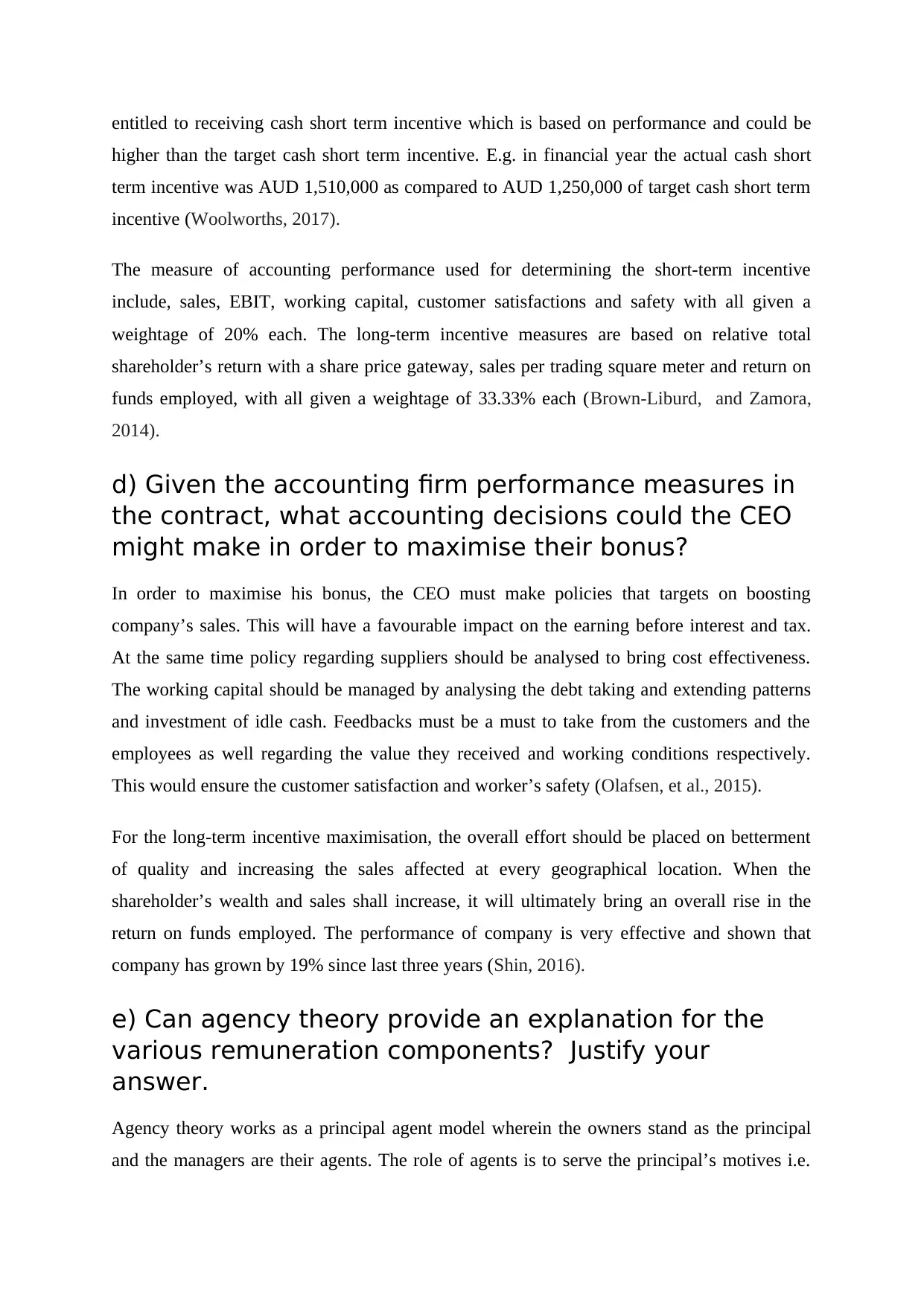
entitled to receiving cash short term incentive which is based on performance and could be
higher than the target cash short term incentive. E.g. in financial year the actual cash short
term incentive was AUD 1,510,000 as compared to AUD 1,250,000 of target cash short term
incentive (Woolworths, 2017).
The measure of accounting performance used for determining the short-term incentive
include, sales, EBIT, working capital, customer satisfactions and safety with all given a
weightage of 20% each. The long-term incentive measures are based on relative total
shareholder’s return with a share price gateway, sales per trading square meter and return on
funds employed, with all given a weightage of 33.33% each (Brown-Liburd, and Zamora,
2014).
d) Given the accounting firm performance measures in
the contract, what accounting decisions could the CEO
might make in order to maximise their bonus?
In order to maximise his bonus, the CEO must make policies that targets on boosting
company’s sales. This will have a favourable impact on the earning before interest and tax.
At the same time policy regarding suppliers should be analysed to bring cost effectiveness.
The working capital should be managed by analysing the debt taking and extending patterns
and investment of idle cash. Feedbacks must be a must to take from the customers and the
employees as well regarding the value they received and working conditions respectively.
This would ensure the customer satisfaction and worker’s safety (Olafsen, et al., 2015).
For the long-term incentive maximisation, the overall effort should be placed on betterment
of quality and increasing the sales affected at every geographical location. When the
shareholder’s wealth and sales shall increase, it will ultimately bring an overall rise in the
return on funds employed. The performance of company is very effective and shown that
company has grown by 19% since last three years (Shin, 2016).
e) Can agency theory provide an explanation for the
various remuneration components? Justify your
answer.
Agency theory works as a principal agent model wherein the owners stand as the principal
and the managers are their agents. The role of agents is to serve the principal’s motives i.e.
higher than the target cash short term incentive. E.g. in financial year the actual cash short
term incentive was AUD 1,510,000 as compared to AUD 1,250,000 of target cash short term
incentive (Woolworths, 2017).
The measure of accounting performance used for determining the short-term incentive
include, sales, EBIT, working capital, customer satisfactions and safety with all given a
weightage of 20% each. The long-term incentive measures are based on relative total
shareholder’s return with a share price gateway, sales per trading square meter and return on
funds employed, with all given a weightage of 33.33% each (Brown-Liburd, and Zamora,
2014).
d) Given the accounting firm performance measures in
the contract, what accounting decisions could the CEO
might make in order to maximise their bonus?
In order to maximise his bonus, the CEO must make policies that targets on boosting
company’s sales. This will have a favourable impact on the earning before interest and tax.
At the same time policy regarding suppliers should be analysed to bring cost effectiveness.
The working capital should be managed by analysing the debt taking and extending patterns
and investment of idle cash. Feedbacks must be a must to take from the customers and the
employees as well regarding the value they received and working conditions respectively.
This would ensure the customer satisfaction and worker’s safety (Olafsen, et al., 2015).
For the long-term incentive maximisation, the overall effort should be placed on betterment
of quality and increasing the sales affected at every geographical location. When the
shareholder’s wealth and sales shall increase, it will ultimately bring an overall rise in the
return on funds employed. The performance of company is very effective and shown that
company has grown by 19% since last three years (Shin, 2016).
e) Can agency theory provide an explanation for the
various remuneration components? Justify your
answer.
Agency theory works as a principal agent model wherein the owners stand as the principal
and the managers are their agents. The role of agents is to serve the principal’s motives i.e.
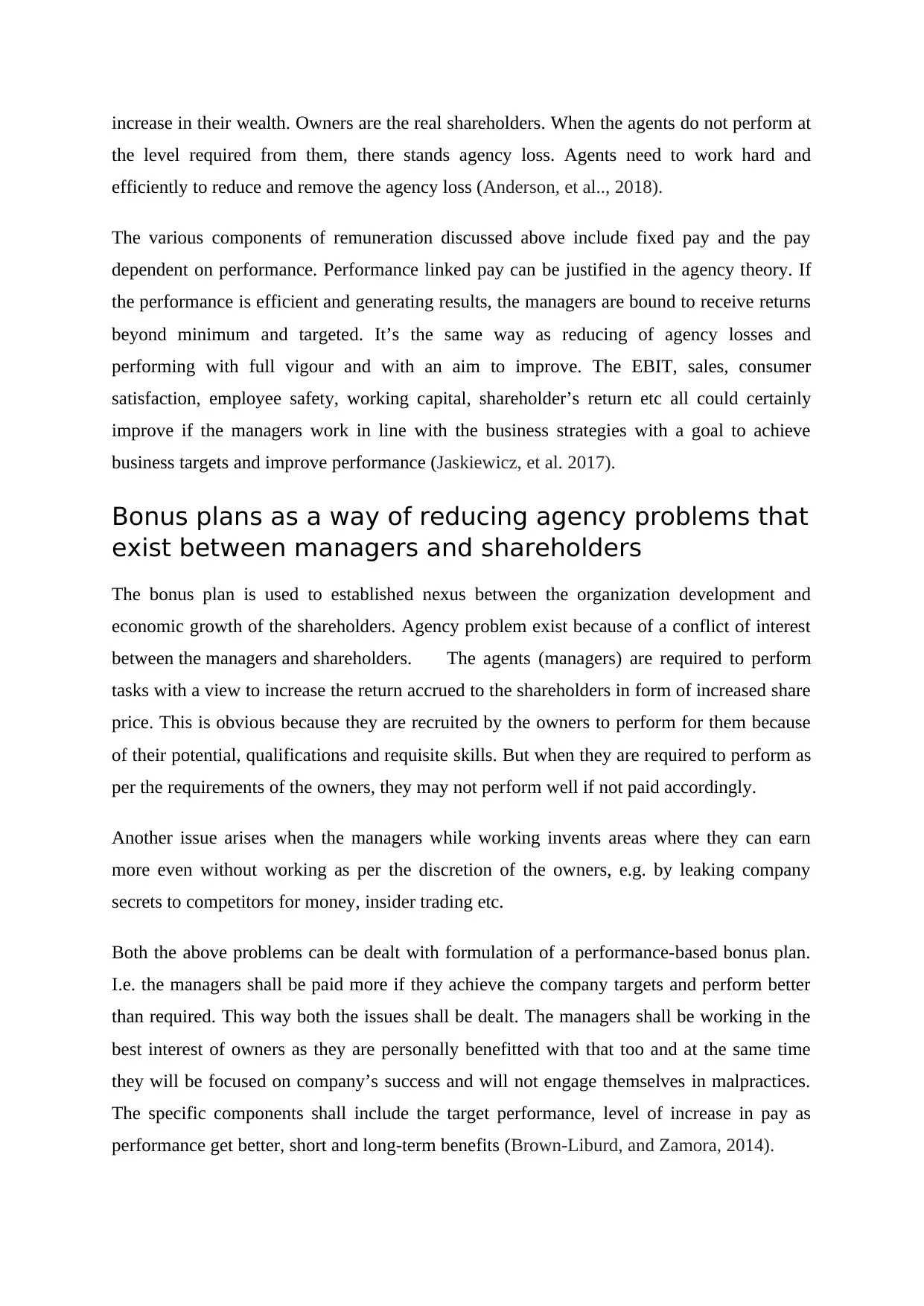
increase in their wealth. Owners are the real shareholders. When the agents do not perform at
the level required from them, there stands agency loss. Agents need to work hard and
efficiently to reduce and remove the agency loss (Anderson, et al.., 2018).
The various components of remuneration discussed above include fixed pay and the pay
dependent on performance. Performance linked pay can be justified in the agency theory. If
the performance is efficient and generating results, the managers are bound to receive returns
beyond minimum and targeted. It’s the same way as reducing of agency losses and
performing with full vigour and with an aim to improve. The EBIT, sales, consumer
satisfaction, employee safety, working capital, shareholder’s return etc all could certainly
improve if the managers work in line with the business strategies with a goal to achieve
business targets and improve performance (Jaskiewicz, et al. 2017).
Bonus plans as a way of reducing agency problems that
exist between managers and shareholders
The bonus plan is used to established nexus between the organization development and
economic growth of the shareholders. Agency problem exist because of a conflict of interest
between the managers and shareholders. The agents (managers) are required to perform
tasks with a view to increase the return accrued to the shareholders in form of increased share
price. This is obvious because they are recruited by the owners to perform for them because
of their potential, qualifications and requisite skills. But when they are required to perform as
per the requirements of the owners, they may not perform well if not paid accordingly.
Another issue arises when the managers while working invents areas where they can earn
more even without working as per the discretion of the owners, e.g. by leaking company
secrets to competitors for money, insider trading etc.
Both the above problems can be dealt with formulation of a performance-based bonus plan.
I.e. the managers shall be paid more if they achieve the company targets and perform better
than required. This way both the issues shall be dealt. The managers shall be working in the
best interest of owners as they are personally benefitted with that too and at the same time
they will be focused on company’s success and will not engage themselves in malpractices.
The specific components shall include the target performance, level of increase in pay as
performance get better, short and long-term benefits (Brown-Liburd, and Zamora, 2014).
the level required from them, there stands agency loss. Agents need to work hard and
efficiently to reduce and remove the agency loss (Anderson, et al.., 2018).
The various components of remuneration discussed above include fixed pay and the pay
dependent on performance. Performance linked pay can be justified in the agency theory. If
the performance is efficient and generating results, the managers are bound to receive returns
beyond minimum and targeted. It’s the same way as reducing of agency losses and
performing with full vigour and with an aim to improve. The EBIT, sales, consumer
satisfaction, employee safety, working capital, shareholder’s return etc all could certainly
improve if the managers work in line with the business strategies with a goal to achieve
business targets and improve performance (Jaskiewicz, et al. 2017).
Bonus plans as a way of reducing agency problems that
exist between managers and shareholders
The bonus plan is used to established nexus between the organization development and
economic growth of the shareholders. Agency problem exist because of a conflict of interest
between the managers and shareholders. The agents (managers) are required to perform
tasks with a view to increase the return accrued to the shareholders in form of increased share
price. This is obvious because they are recruited by the owners to perform for them because
of their potential, qualifications and requisite skills. But when they are required to perform as
per the requirements of the owners, they may not perform well if not paid accordingly.
Another issue arises when the managers while working invents areas where they can earn
more even without working as per the discretion of the owners, e.g. by leaking company
secrets to competitors for money, insider trading etc.
Both the above problems can be dealt with formulation of a performance-based bonus plan.
I.e. the managers shall be paid more if they achieve the company targets and perform better
than required. This way both the issues shall be dealt. The managers shall be working in the
best interest of owners as they are personally benefitted with that too and at the same time
they will be focused on company’s success and will not engage themselves in malpractices.
The specific components shall include the target performance, level of increase in pay as
performance get better, short and long-term benefits (Brown-Liburd, and Zamora, 2014).
⊘ This is a preview!⊘
Do you want full access?
Subscribe today to unlock all pages.

Trusted by 1+ million students worldwide
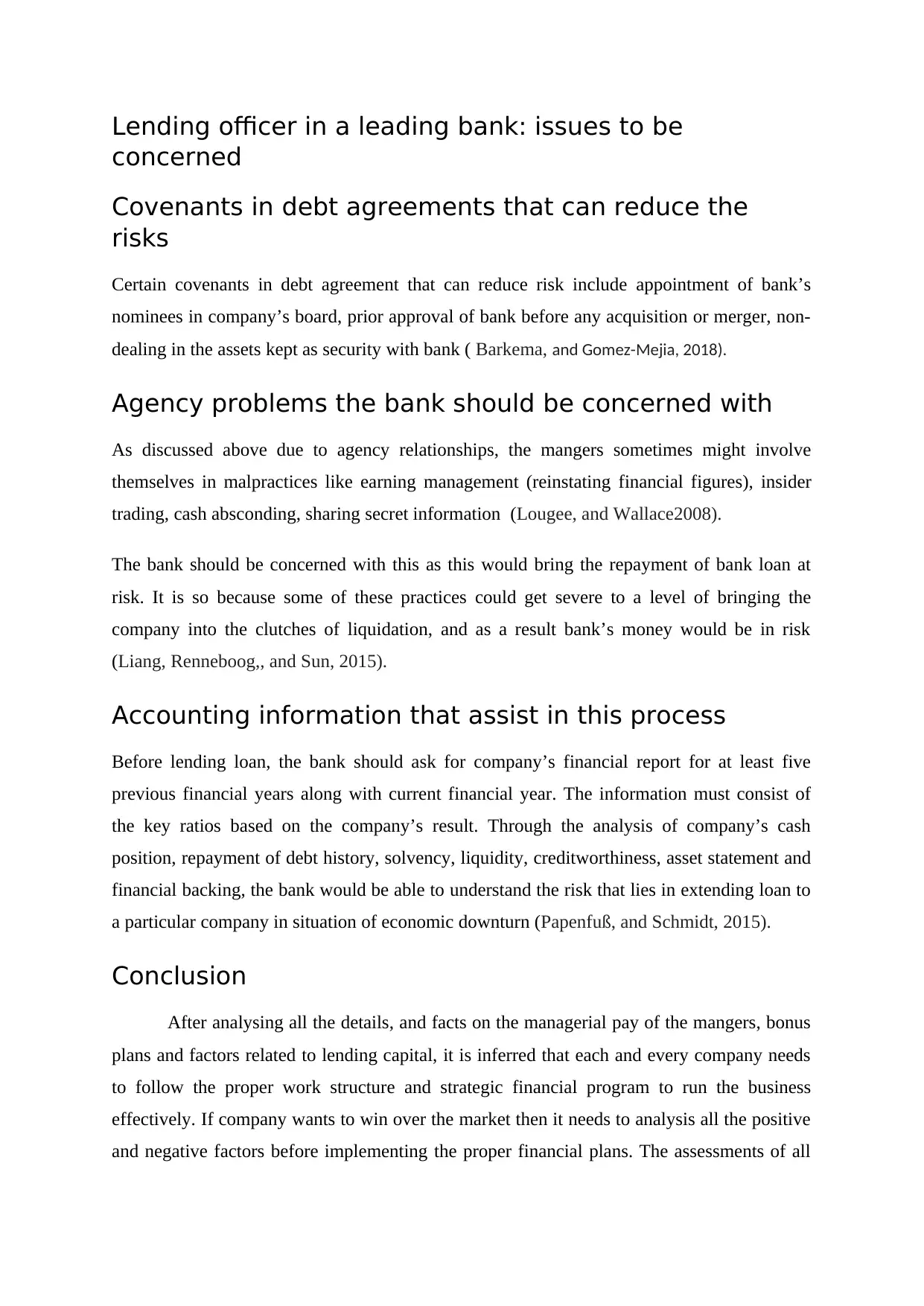
Lending officer in a leading bank: issues to be
concerned
Covenants in debt agreements that can reduce the
risks
Certain covenants in debt agreement that can reduce risk include appointment of bank’s
nominees in company’s board, prior approval of bank before any acquisition or merger, non-
dealing in the assets kept as security with bank ( Barkema, and Gomez-Mejia, 2018).
Agency problems the bank should be concerned with
As discussed above due to agency relationships, the mangers sometimes might involve
themselves in malpractices like earning management (reinstating financial figures), insider
trading, cash absconding, sharing secret information (Lougee, and Wallace2008).
The bank should be concerned with this as this would bring the repayment of bank loan at
risk. It is so because some of these practices could get severe to a level of bringing the
company into the clutches of liquidation, and as a result bank’s money would be in risk
(Liang, Renneboog,, and Sun, 2015).
Accounting information that assist in this process
Before lending loan, the bank should ask for company’s financial report for at least five
previous financial years along with current financial year. The information must consist of
the key ratios based on the company’s result. Through the analysis of company’s cash
position, repayment of debt history, solvency, liquidity, creditworthiness, asset statement and
financial backing, the bank would be able to understand the risk that lies in extending loan to
a particular company in situation of economic downturn (Papenfuß, and Schmidt, 2015).
Conclusion
After analysing all the details, and facts on the managerial pay of the mangers, bonus
plans and factors related to lending capital, it is inferred that each and every company needs
to follow the proper work structure and strategic financial program to run the business
effectively. If company wants to win over the market then it needs to analysis all the positive
and negative factors before implementing the proper financial plans. The assessments of all
concerned
Covenants in debt agreements that can reduce the
risks
Certain covenants in debt agreement that can reduce risk include appointment of bank’s
nominees in company’s board, prior approval of bank before any acquisition or merger, non-
dealing in the assets kept as security with bank ( Barkema, and Gomez-Mejia, 2018).
Agency problems the bank should be concerned with
As discussed above due to agency relationships, the mangers sometimes might involve
themselves in malpractices like earning management (reinstating financial figures), insider
trading, cash absconding, sharing secret information (Lougee, and Wallace2008).
The bank should be concerned with this as this would bring the repayment of bank loan at
risk. It is so because some of these practices could get severe to a level of bringing the
company into the clutches of liquidation, and as a result bank’s money would be in risk
(Liang, Renneboog,, and Sun, 2015).
Accounting information that assist in this process
Before lending loan, the bank should ask for company’s financial report for at least five
previous financial years along with current financial year. The information must consist of
the key ratios based on the company’s result. Through the analysis of company’s cash
position, repayment of debt history, solvency, liquidity, creditworthiness, asset statement and
financial backing, the bank would be able to understand the risk that lies in extending loan to
a particular company in situation of economic downturn (Papenfuß, and Schmidt, 2015).
Conclusion
After analysing all the details, and facts on the managerial pay of the mangers, bonus
plans and factors related to lending capital, it is inferred that each and every company needs
to follow the proper work structure and strategic financial program to run the business
effectively. If company wants to win over the market then it needs to analysis all the positive
and negative factors before implementing the proper financial plans. The assessments of all
Paraphrase This Document
Need a fresh take? Get an instant paraphrase of this document with our AI Paraphraser

the financial activities are utmost required for the balanced and transparent busienss
functioning.
functioning.
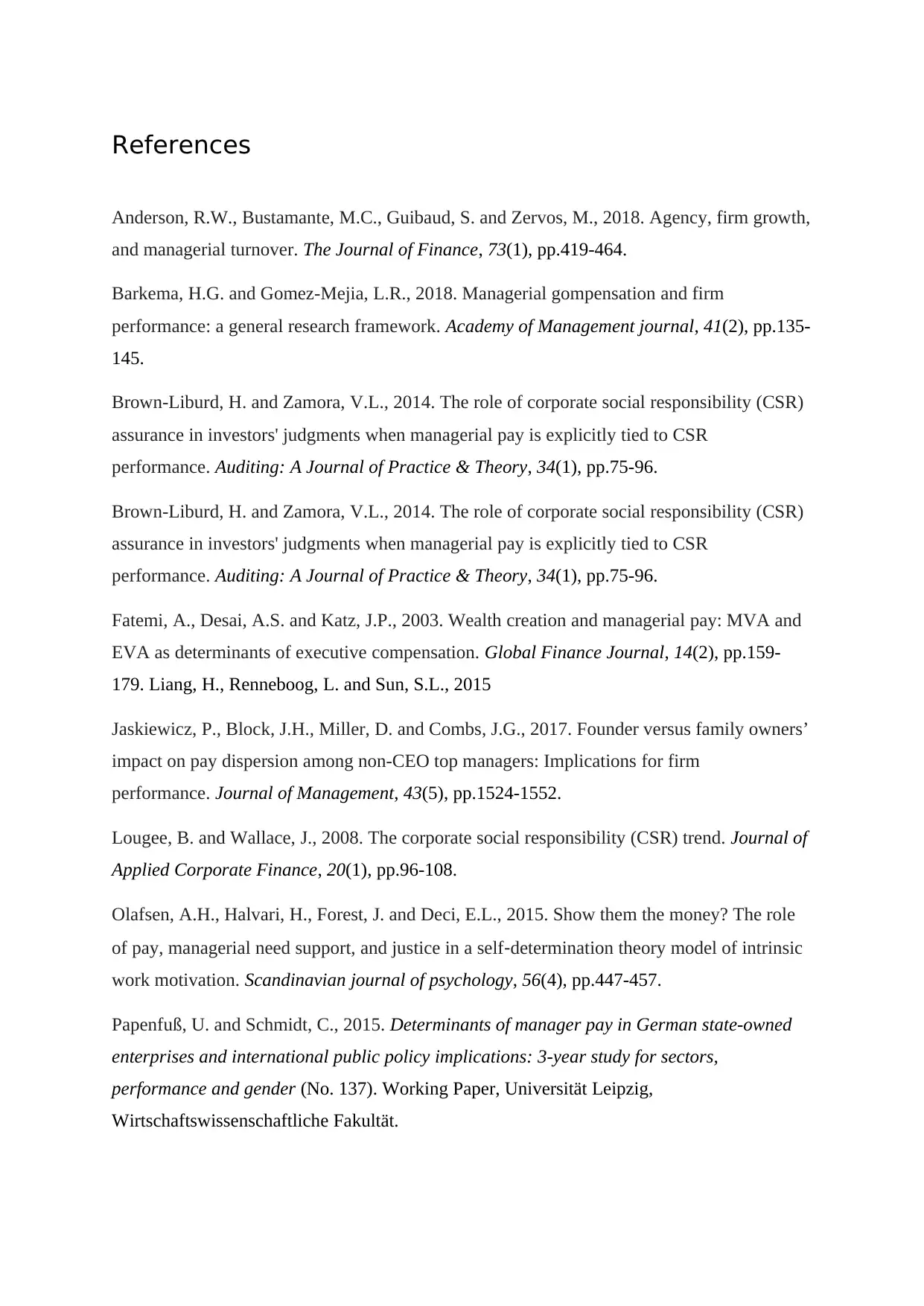
References
Anderson, R.W., Bustamante, M.C., Guibaud, S. and Zervos, M., 2018. Agency, firm growth,
and managerial turnover. The Journal of Finance, 73(1), pp.419-464.
Barkema, H.G. and Gomez-Mejia, L.R., 2018. Managerial gompensation and firm
performance: a general research framework. Academy of Management journal, 41(2), pp.135-
145.
Brown-Liburd, H. and Zamora, V.L., 2014. The role of corporate social responsibility (CSR)
assurance in investors' judgments when managerial pay is explicitly tied to CSR
performance. Auditing: A Journal of Practice & Theory, 34(1), pp.75-96.
Brown-Liburd, H. and Zamora, V.L., 2014. The role of corporate social responsibility (CSR)
assurance in investors' judgments when managerial pay is explicitly tied to CSR
performance. Auditing: A Journal of Practice & Theory, 34(1), pp.75-96.
Fatemi, A., Desai, A.S. and Katz, J.P., 2003. Wealth creation and managerial pay: MVA and
EVA as determinants of executive compensation. Global Finance Journal, 14(2), pp.159-
179. Liang, H., Renneboog, L. and Sun, S.L., 2015
Jaskiewicz, P., Block, J.H., Miller, D. and Combs, J.G., 2017. Founder versus family owners’
impact on pay dispersion among non-CEO top managers: Implications for firm
performance. Journal of Management, 43(5), pp.1524-1552.
Lougee, B. and Wallace, J., 2008. The corporate social responsibility (CSR) trend. Journal of
Applied Corporate Finance, 20(1), pp.96-108.
Olafsen, A.H., Halvari, H., Forest, J. and Deci, E.L., 2015. Show them the money? The role
of pay, managerial need support, and justice in a self‐determination theory model of intrinsic
work motivation. Scandinavian journal of psychology, 56(4), pp.447-457.
Papenfuß, U. and Schmidt, C., 2015. Determinants of manager pay in German state-owned
enterprises and international public policy implications: 3-year study for sectors,
performance and gender (No. 137). Working Paper, Universität Leipzig,
Wirtschaftswissenschaftliche Fakultät.
Anderson, R.W., Bustamante, M.C., Guibaud, S. and Zervos, M., 2018. Agency, firm growth,
and managerial turnover. The Journal of Finance, 73(1), pp.419-464.
Barkema, H.G. and Gomez-Mejia, L.R., 2018. Managerial gompensation and firm
performance: a general research framework. Academy of Management journal, 41(2), pp.135-
145.
Brown-Liburd, H. and Zamora, V.L., 2014. The role of corporate social responsibility (CSR)
assurance in investors' judgments when managerial pay is explicitly tied to CSR
performance. Auditing: A Journal of Practice & Theory, 34(1), pp.75-96.
Brown-Liburd, H. and Zamora, V.L., 2014. The role of corporate social responsibility (CSR)
assurance in investors' judgments when managerial pay is explicitly tied to CSR
performance. Auditing: A Journal of Practice & Theory, 34(1), pp.75-96.
Fatemi, A., Desai, A.S. and Katz, J.P., 2003. Wealth creation and managerial pay: MVA and
EVA as determinants of executive compensation. Global Finance Journal, 14(2), pp.159-
179. Liang, H., Renneboog, L. and Sun, S.L., 2015
Jaskiewicz, P., Block, J.H., Miller, D. and Combs, J.G., 2017. Founder versus family owners’
impact on pay dispersion among non-CEO top managers: Implications for firm
performance. Journal of Management, 43(5), pp.1524-1552.
Lougee, B. and Wallace, J., 2008. The corporate social responsibility (CSR) trend. Journal of
Applied Corporate Finance, 20(1), pp.96-108.
Olafsen, A.H., Halvari, H., Forest, J. and Deci, E.L., 2015. Show them the money? The role
of pay, managerial need support, and justice in a self‐determination theory model of intrinsic
work motivation. Scandinavian journal of psychology, 56(4), pp.447-457.
Papenfuß, U. and Schmidt, C., 2015. Determinants of manager pay in German state-owned
enterprises and international public policy implications: 3-year study for sectors,
performance and gender (No. 137). Working Paper, Universität Leipzig,
Wirtschaftswissenschaftliche Fakultät.
⊘ This is a preview!⊘
Do you want full access?
Subscribe today to unlock all pages.

Trusted by 1+ million students worldwide

Shin, T., 2016. Fair pay or power play? Pay equity, managerial power, and compensation
adjustments for CEOs. Journal of Management, 42(2), pp.419-448.
Woolworths, 2017., Annual report., [Online]., Available at
https://www.woolworthsgroup.com.au/icms_docs/188795_annual-report-2017.pdf.,
[Accessed 14th May, 2018].
adjustments for CEOs. Journal of Management, 42(2), pp.419-448.
Woolworths, 2017., Annual report., [Online]., Available at
https://www.woolworthsgroup.com.au/icms_docs/188795_annual-report-2017.pdf.,
[Accessed 14th May, 2018].
1 out of 10
Related Documents
Your All-in-One AI-Powered Toolkit for Academic Success.
+13062052269
info@desklib.com
Available 24*7 on WhatsApp / Email
![[object Object]](/_next/static/media/star-bottom.7253800d.svg)
Unlock your academic potential
Copyright © 2020–2025 A2Z Services. All Rights Reserved. Developed and managed by ZUCOL.





